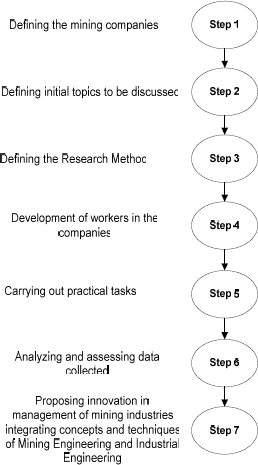LA APLICACIÓN DE LA ADMINISTRACIÓN LEAN EN LAS INDUSTRIAS DE MINERÍA
Palabras clave:
Innovación, Minería, Administración, Sistema de Producción Toyota, Producción Lean (es)Entre las alternativas para asegurar su supervivencia, una particularmente pertinente para las
Organizaciones es la innovación. La innovación tiene varias dimensiones entre que es posible incluir: i) materia prima; ii) producto; iii) proceso; iv) mercado; v) la manera cómo es realizada la administración. Este artículo tiene el objetivo de mostrar la posibilidad de llevar a cabo una nueva manera de dirección en las industrias de extracción de mineral a través del uso integrado de los conceptos desarrollados en la construcción del Sistema de Producción Toyota (SPT) / el Sistema de Producción Lean, y los conceptos y técnicas tradicionales que se originan de la Ingeniería Minera y la Ingeniería Industrial. El artículo muestra esta integración en dos situaciones de la minería (fluorita y amatista). Los resultados indican la reducción del costo de la producción y aumento de la productividad y la mejora de la Calidad de Vida de Trabajadores.
LEAN MANAGEMENT IMPLEMENTATION IN MINING INDUSTRIES
LA APLICACIÓN DE LA ADMINISTRACIÓN LEAN EN LAS INDUSTRIAS DE MINERÍA
ALTAIR FLAMARION KLIPPEL
Profesor en la Universidad del
Vale do Rio dos Sinos, altair@klippel.com.br
CARLOS
OTÁVIO PETTER
Profesor en la Universidad Federal
de Rio Grande do Sul, cpetter@ufrgs.br
JOSÉ ANTONIO
VALLE ANTUNES JR
Profesor en la Universidad del
Vale do Rio dos Sinos, junico@produttare.com.br
Recibido para revisar Febrero 06 de 2007, aceptado Diciembre 12 de 2007, versión final Diciembre 26 de 2007
RESUMEN: Entre las alternativas para asegurar su supervivencia, una particularmente pertinente para las Organizaciones es la innovación. La innovación tiene varias dimensiones entre que es posible incluir: i) materia prima; ii) producto; iii) proceso; iv) mercado; v) la manera cómo es realizada la administración. Este artículo tiene el objetivo de mostrar la posibilidad de llevar a cabo una nueva manera de dirección en las industrias de extracción de mineral a través del uso integrado de los conceptos desarrollados en la construcción del Sistema de Producción Toyota (SPT) / el Sistema de Producción Lean, y los conceptos y técnicas tradicionales que se originan de la Ingeniería Minera y la Ingeniería Industrial. El artículo muestra esta integración en dos situaciones de la minería (fluorita y amatista). Los resultados indican la reducción del costo de la producción y aumento de la productividad y la mejora de la Calidad de Vida de Trabajadores.
PALABRAS CLAVE: Innovación, Minería, Administración, Sistema de Producción Toyota, Producción Lean
ABSTRACT: Among the alternatives to assure its survival, a particularly relevant one for Organizations is innovation. Innovation has several dimensions among which it is possible to include: i) raw material; ii) product; iii) process; iv) market; v) the way how administration is made. This paper has the objective to show the possibility to implement a new management way in the industries of mineral extraction through the integrated use of the concepts developed in the construction of the Toyota of Production System (TPS)/ Lean Production System, and the concepts and traditional techniques originating from the Mining Engineering and the Industrial Engineering. The paper shows this integration in two sceneries of the mining (fluospar and amethyst). The results indicate the reduction of the production costs and increase of the productivity and the improvement of the Workers Life Quality.
KEYWORDS: Mining, Management, Innovation, Toyota Production System, Lean Production
1. INTRODUCTION
It is possible to devise efficient ways of utilizing production resources available in mining companies by means of modern management technologies involving: (i) the flow of raw-material, (ii) personnel management; and (iii) equipment management.
Mineral raw material is obtained through mining and processing methods specific to each kind of mine and ore. The technological knowledge of these mining and processing methods is not enough to ensure the survival of mining organizations.
It is also necessary that the management methods be aligned with the logic of competitiveness seeking a reduction in production costs and an increase in profits.
The present paper aims to present the potential of a new form of management in mining companies through the integrated and synergic use of concepts developed by the Toyota Production System/Lean Production and the concepts and traditional techniques derived from Mining Engineering and Industrial Engineering.
2. METHOD
The Research Method followed in the development of this paper was the Survey-Action Method. The Working Method, grounded on the general principles defended by the Survey-Action Method describes the objective steps leading to the fulfillment of the study.
2.1 Research
Method
The
Survey-Action Method fosters the involvement of workers in the research process
based on the fact that it encourages the urge of an intense interaction between
the researcher and the workers of the company under study.
Thiollent (1997) states that the Survey-Action tool suggests conducting a survey involving individuals or groups at different hierarchical levels in the organization in connection with the problem in order to get a diagnosis that will lead to changes in the organization.
Thiollent (2002) considers every Survey-Action a kind of involvement once the participation of individuals engaged in the problem is absolutely necessary.
2.2 Working
Method
In
this study, the Working Method proposing an innovation in the management
of mining companies is represented in Figure 1, consisting of the following
steps:
Step 1: Defining the mining companies in order to propose the development of this study. Two mining companies were chosen (fluorspar and amethyst), located in the Southern Region of Brazil.
Step 2: Defining initial topics to be discussed. It was decided to use the Toyota Production System concepts and techniques to be integrated with the concepts and techniques of Mining Engineering and Production Engineering.
Step 3: Defining the Research Method. The Survey-Action methodology was selected.
Step 4: Development of workers in the company. Theoretical meetings were held between the authors of this paper and the workers of the companies.
Step 5: Carrying out practical tasks. Workers of the companies collected and analyzed data in the underground mining.
Step 6: Analyzing and assessing data collected. This activity is based on the practical tasks performed in the previous step.
Step 7: Proposing innovation in the management of mining industries through this paper integrating concepts and techniques of Mining Engineering and Industrial Engineering.
3. THEORETICAL REFERENCE
The Theoretical Reference adopted in this study is presented next. Topics were as follows: i) Value; ii) Innovation; iii) Toyota Production System.
3.1 Value
The value of a product may be defined by the relation between
its function and cost. One may say that the value of a product is the lowest
cost attributed to a product or service which must meet the costumer’s expectation and it
is called “added value”. From the producer’s point of view, value is related
to profit, that is, the value of the product will be as big as the appropriation
of riches resulting from this product along the chain. This value is called “appropriated
value” (CSILLAC, 1991).
Antunes et alli (2007) comment that the analysis of the value chain of a specific product will suggest opportunities and needs for innovation not only in the development of the product itself, but also in terms of progress, production and logistics of materials.
3.2 Innovation
In a competitive and globalized scenario like today,
innovation is an essential element for the survival of organizations. According
to Schumpeter (1982, p.112) “the fundamental impulse that starts and keeps the change process
in organizations stems from news consumer goods, new methods of production
and transportation, new markets and forms of industrial organization devised
by the same”.
Schumpeter (1976) main precursor of the innovation theory, featured the following general types of innovations: i) introduction of a new product or a qualitative change in an existing product; ii) innovation of a process completely new to an industry; iii) opening a new market; iv) development of new sources of raw material supply and other inputs and v) changes in the industrial organization through the change of the form of management.
These five types of innovation may be copied by the competitors more or less easily. The most complicated type of innovation to be replicated is the management innovation because presumably one must understand a range of principles that oftentimes carry a cultural content difficult to understand if you are not familiar with the internal environment of a company.
Urabe (1988) apud Popadiuk and Choo (2007) says that “Innovation consists of the generation of a new idea and its implementation into a new product, process or service, leading to the dynamic growth of the national economy and the increase of employment as well as to a creation of pure profit for the innovative business enterprise. Innovation is never a one-time phenomenon, but a long and cumulative process of a great number of organizational decision-making process, ranging from the phase of generation of a new idea to its implementation phase. New idea refers to the perception of a new customer need or a new way to produce. It is generated in the cumulative process of information-gathering, coupled with an ever-challenging entrepreneurial vision. Through the implementation process the new idea is developed and commercialized into a new marketable product or a new process with attendant cost reduction and increased productivity”
Antunes et alli (2007) suggest a model aiming to associate the appropriated value and the activities played by the value chain to a specific organization. In Figure 2 a simplified adaptation of this model is shown.

Figure 2. Innovation x Activities
in the value chain.
The analysis of Figure 2 shows that activities leading to add greater value from the innovation perspective are associated with market innovations. Secondly, activities related to the development of the product are conceptually associated with product and material innovations. Thirdly, process and development activities related to process innovations proportionally tend to add less value to the business process. At this injunction, it is important to point out that innovations may definitely contribute to competitiveness.
To make sure that innovations in the market, product, process and raw material take place efficiently, systematically and systemically it is necessary to adopt management strategies focused on innovations. Adding value through methods of innovative management is important since it formalizes and establishes a constant pursuit for innovation in the organizations.
Among the new management forms is the implementation of new concepts and techniques of the Toyota Production System in unison with the best intrinsic technological practices available in the industry in question (i.e., the mining industry).
Analyzing a generic production system in a mining industry, one may point out the different means of generating innovations, as shown in Figure 3.
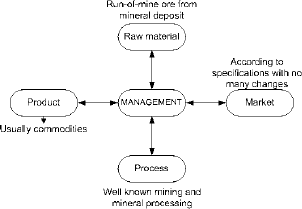
Figure 3. Innovation in
the mining industry.
In the mining industry, the raw material constitutes a natural resource. For this reason, probably this kind of industrial activity is the only one in which innovation does not take place.
Despite the fact that mining process are well-known worldwide, technological advance can enhance them with innovation, for instance, through the use of remote controls to monitor mining equipment in underground coal mines of low thickness.
Products deriving from the mining industry feature well-defined specifications without undergoing great alterations. As new products are developed because of technology, the market innovates, expanding the mining companies’ performance.
The innovation of products, services, processes and market, based on the raw material extracted from nature, may be conquered through a management innovation, responsible for the interaction of the innovation with the other dimensions considered.
3.3 The Toyota Production System
The highly competitive and globalized current world economic scenario highlights
the success of Japanese companies in that it makes Western companies seek
management innovation by copying and adapting their best practices to their
reality, such as the concepts and techniques developed by Toyota Motor Company
during the construction of the Toyota Production System (TPS)/Lean Production
System.
Liker (2005) comments that “when the TPS is applied in a company, the first question is to analyze the production flow from the costumer’s expectation: “What the customer wants with this process?” This defines the value. (LIKER, 2005, p. 46)
Shingo ( 1996 a) states that there are four phenomena underlying the raw material flow: processing – alterations in shape or quality, assembly, disassembly; inspection – a comparison with the standards; transportation – location changes; and waiting – a time when no changes occur (SHINGO, 1996 a, p.39). Of all the phenomena mentioned above, only processing adds value to the product; the others may be seen as a waste (SHINGO, 1996 a, p. 11).
TPS has revolutionized the concept of waste, considering as waste all the activities that generate costs and do not add any value to the product. Analyzing the production system, Shingo identified seven (7) types of wastes, namely: i) overproduction wastes; ii) transportation wastes; iii) processing wastes; iv) defective production wastes; v) waiting; vi) inventory wastes and vii) motion wastes (SHINGO, 1996 a, p. 22).
According to Shingo’s classification (SHINGO, 1996 a, p.76) operations may be useful or useless.
Among the useful ones are the main operations that are classified as essential operations (A) and auxiliary operations (B). Essential operations relate to the net labor, which adds value to the product, whereas auxiliary operations do not add value to the product but are necessary for an essential operation to be carried out. Useless operations (C) mean wastes along the process and must be eliminated.
4. MANAGEMENT INNOVATION IN MINING COMPANIES
Following, two cases of innovation in mining companies are presented: i) the fluorspar mining case and ii) the amethyst mining case.
4.1 Fluorspar mining
This study was conducted in a fluorspar mining company located in the southernmost
region of Santa Catarina State, Brazil, which belongs to Grupo Votorantim,
one of the mining leaders in the country.
Through a careful mapping of the production process based on TPS concepts and techniques it was possible to classify the operations carried out in a mining block underground at the company studied. Figure 3 is the result of this mapping.
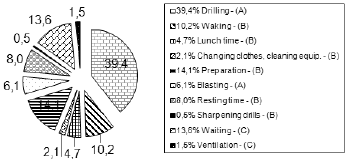
Figure 4. Operations
carried out in a mining block – 1st measurement
Inside the mining block, drilling and blasting are essential operations (A) to be optimized. In the first measurement done only 45.5% of the total amount of time was spent on its execution.
Preparation, an auxiliary operation (B), includes putting down loose rocks from the roof and connecting compressed-air hoses, among other activities. 14.1% of the time was spent on this task. Sharpening drills (0.5%), changing clothes (2.1%), commuting (10.2%) and having lunch (4.7%) are also considered auxiliary activities (B).
The resting period (8.0%) is considered a break from work to relieve miners’ fatigue and is part of the useful operations.
Waiting (13.0%) is considered waste (C) in the process as well as the interruption due to the lack of ventilation (0.5%).
Putting together all operations carried out in the mining block concerning the breakage of ore according Shingo’s classification, Figure 5 is obtained.

Figure 5. Operations
based on Shingo’s classification in a mining block – 1st measurement
The analysis of the data collected made it possible to identify the main causes of the low profit of the operations carried out inside the mining block, pointing out the following wastes:
The essential drilling and blasting operations were performed individually by the driller who was also in charge of sharpening the drills and fetching explosives in the magazine. While he was busy doing such tasks, the drilling machine was idle, which characterizes a waste caused by the processing itself.
Adopting the brainstorming technique, the most significant decision was organizing teams of drillers for the essential operations, with a team of three drillers alternating functions: while two of them perform the drilling, a third one, called supported, performs the other supporting tasks, thus providing a higher value adding time than the previous one.
The drill sharpening operation, included in the driller’s activities, used to cause a waste by the processing itself. The same was transformed into an external setup, where a worker from the mine was placed to perform this task.
Because the compressed-air filters were not lubricated and the hoses were excessively long and reduced in diameter, there was also a waste by the processing itself in the essential operation.
The stop valves in the compressed air and water hoses were too far from the other end of the drilling machine so that the drillers had to come and go to shut off and open the valves, thus interrupting the drilling task, causing a waste by motion as well as the lack of tools used for putting down loose rocks from the roof inside the block.
The correction of this condition transformed the wasted time into added value time in the drilling operation and also made drillers less tired.
Because of the lack of efficient ventilation inside the block, drillers had to wait after the blasting until the gases had been released, causing a waste by waiting as well as the lack of a spare drilling machine inside the block and the distance from the magazine, located on the other level of the mine. Table 1 shows the wastes and the actions taken to eliminate them.
Table 1. Wastes x Actions
taken in a mining block
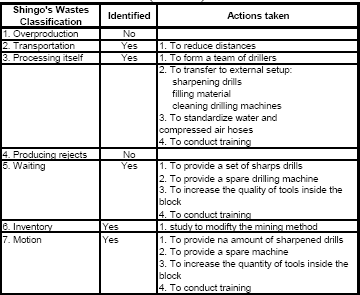
Once the previous discussed and analysed improvement were done, a new measurement was carried out, resulting in the data shown in Figure 6.
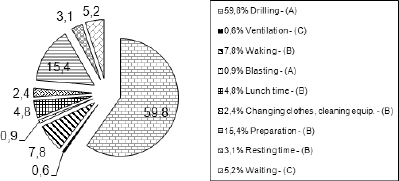
Figure 6. Operations
carried out in a mining block – 2nd measurement
Putting together the operations concerning the extraction of ore in the mining block according to Shingo’s classification, Figure 7 is obtained.
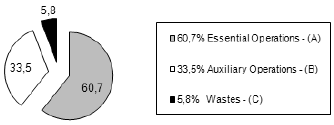
Figure 7. Operations
based on Shingo’s classification in a mining block – 2nd measurement
The comparative analysis of the data obtained from the two measurements, shown in Table 2, allows the conclusion that implementation of the improvements proposed increased the useful time of the essential operation, reducing the time spent on auxiliary operations and on wastes.
Table 2. Comparison of measurement
timing

The evolution of the main data, after and before implementation of improvements is shown in Table 3.
Table 3. Main comparative
data

The analysis shows that the volume of ore extracted in the block went from 15.72 tons/driller to 22.58 tons/driller. As a result, the monthy volume extracted inside the block increased gradually, going from 5,661 tons to 8,129 tons, representing a higher yield in relation to the first measurement of 43.6%.
The plan of costs of the company shows that the cost per ton extracted inside the block during the improvement implementation period was reduced from US$ 5.23/ton to US$ 3.51/ton.
4.2 Amethyst mining
The production process of this type of mineral, in the North of Rio Grande
do Sul State, Brazil , is limited to a rudimentary underground mining method
using hillside galleries.
The cycle task in this mining method comprises i) drilling; ii) explosive loading; iii) blasting and waiting for gas dispersion; iv) removal of the broken rock; v) geode quality assurance and vi) geode removal.
In a pilot mining area, the main problems identified were the necessity of removing the drilling dust, as well as eliminating the blasting gases, since they are harmful and decrease the workers’ life expectation and quality.
Based on the mapping process done in this pilot mining area, in a five day period, the subsequent results are presented in Table 4 and Figure 8.
Table 4. Tabulated data in
the pilot mining area (minutes) after improvements


Figure 8. Percentual of activities
in an amethyst mining area after improvements
According to these data, less then 50% of the time was used to processing adds value to the product, showing that it was necessary to realize improvements to increase the add value time of the process.
Table 4 indicates waiting as the major waste, corresponding to more than 50% of the monitored time period. Among all the monitored period wastes, it is possible to highlight:
Waiting waste: the dust removal waiting period, a consequence of dry drilling and blasting gases in an inefficient ventilation system are the two of major causes of waiting wastes. The installation of exhauster fans and ventilation ducts reduces this type of waste, thereby improving the working environment due to the reduction of dust concentration inside the galleries. The dust reduction in the gallery, together with the introduction of a wet drilling process, is shown in Table 5.
Table 5. Dust concentration
inside the gallery in the pilot mining area

Processing waste: the use of a dry drilling process increases the necessary time to drill holes, causing health problems to workers as well. When introducing the wet drilling process, the processing time was reduced, so that it: i) enhanced the visibility of all tasks; ii) improved productivity by reducing the dust and gas removal waiting time and iii) reduced accident risk. The use of fast clips to connect the compressed air/water hoses with the drilling equipment also reduced the processing waste.
Motion waste: when restricting the availability of drilling equipment to a smaller number of working faces, located close to each other, the worker’s motion time – used to pick up the equipment – was reduced, also reducing its movement. Studies should be developed in order to define the maximum number of working faces that an individual drill is responsible for, focusing on not causing any kind of interruption in the operation, thereby reducing workers’ movements and minimizing motion wastes.
Before implementation of improvements to reduce wastes mentioned above, a new measurement was carried out in a four day period. The data collected are shown in Table 6 and figure 9.
Table 6.Tabulated data in
the pilot mining area (minutes) before improvements

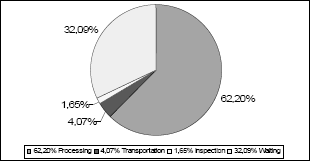
Figure 9. Percentual of activities
in an amethyst mining area before improvements
The comparison of data collected after and before implementation of improvements to increase the add value time of the process is shown in Table 7.
Table 7.Data collected after
and before implementation of improvements
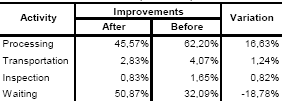
5. CONCLUSIONS
The purpose of this paper is to show the possibility of implementing a new form of management in mining industries through the integrated use of concepts developed in the construction of the Toyota Production System (TPS)/Lean Production System with the concepts and traditional techniques stemming from Mining Engineering and Industrial Engineering.
This paper shows this integration in two mining companies (fluorspar and amethyst). In the first one, there was a cost reduction from US$ 5.23 to US$ 3.51 inside the mining block, corresponding to 32.9% and increase in productivity of 43.6% while in the second company the main improvement was in relation to Worker’s Quality of Life (WQL) by reducing the dust concentration inside the galleries from 60.3 mg/m3 to 3.2 mg/m3, simultaneously reducing the waste caused by waiting from 50,87% to 32,09% of the waiting time. In consequence of the actions taken, there was a 16,63% increase on the add value time of the process.
The results obtained through the practical use of the Survey-Action Method show the potentials of adopting the integrated model proposed – The Toyota Production System and the best Mining Engineering Practices – in true-to-life cases. Furthermore it is important to emphasize that the innovation concepts are a significant backcloth for the integration and synergy proposed in this paper.
REFERENCES
[1] ANTUNES
J. A. V., PANTALEÃO, L. H., PELLEGRIN, I. A Inovação e a Curva da Riqueza, Foz do Iguaçu, Paraná.
ENEGEP 2007
[2] CSILLAC, J.M. Análise de Valor: metodologia do valor. São Paulo:
Atlas, 1991.
[3] LIKER, JEFFREY K. O Modelo Toyota: 14 princípios de gestão do maior
fabricante do mundo. Porto Alegre: Bookman, 2005.
[4] POPADIUK, S., CHOO, C. W. Innovation and knowledge creation: How
are these concepts related? International Journal of Information Management,
Volume 27, Issue 1, 01february 2007, p. 302 – 312.
[5] SHINGO, SHIGEO. O Sistema Toyota de Produção: Do ponto de vista da engenharia de produção.
Porto Alegre: Bookman, 1996 a.
[6] SCHUMPETER, JOSEPH A. Teoria do Desenvolvimento Econômico: uma investigação sobre Lucros, Capital, Crédito, Juro e o Ciclo Econômico. Coleção Os Economistas. São
Paulo: Abril Cultural,1982.
[7] SCHUMPETER, J. A. Capitalism, Socialism and Democracy. New York:
Harper & Brothers, 1976.
[8] THIOLLENT, MICHAEL. Pesquisa-Ação nas Organizações. São Paulo:
1997.
[9] THIOLLENT, MICHAEL. Metodologia da Pesquisa-Ação. 11ª ed. São Paulo:
Cortez, 2002.
Cómo citar
IEEE
ACM
ACS
APA
ABNT
Chicago
Harvard
MLA
Turabian
Vancouver
Descargar cita
Visitas a la página del resumen del artículo
Descargas
Licencia
Derechos de autor 2008 DYNA

Esta obra está bajo una licencia internacional Creative Commons Atribución-NoComercial-SinDerivadas 4.0.
El autor o autores de un artículo aceptado para publicación en cualquiera de las revistas editadas por la facultad de Minas cederán la totalidad de los derechos patrimoniales a la Universidad Nacional de Colombia de manera gratuita, dentro de los cuáles se incluyen: el derecho a editar, publicar, reproducir y distribuir tanto en medios impresos como digitales, además de incluir en artículo en índices internacionales y/o bases de datos, de igual manera, se faculta a la editorial para utilizar las imágenes, tablas y/o cualquier material gráfico presentado en el artículo para el diseño de carátulas o posters de la misma revista.




